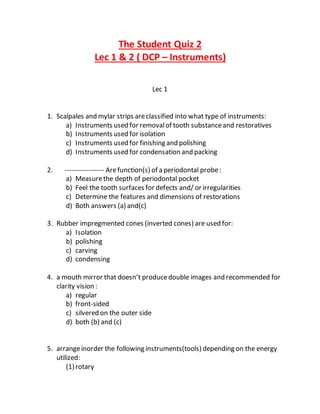
Instrument 2
- 1. The Student Quiz 2 Lec 1 & 2 ( DCP – Instruments) Lec 1 1. Scalpales and mylar strips areclassified into what type of instruments: a) Instruments used for removalof tooth substanceand restoratives b) Instruments used for isolation c) Instruments used for finishing and polishing d) Instruments used for condensation and packing 2. ----------------- Arefunction(s) of a periodontal probe: a) Measurethe depth of periodontal pocket b) Feel the tooth surfaces for defects and/ or irregularities c) Determine the features and dimensions of restorations d) Both answers (a) and(c) 3. Rubber impregmented cones (inverted cones) are used for: a) Isolation b) polishing c) carving d) condensing 4. a mouth mirror that doesn’t producedouble images and recommended for clarity vision : a) regular b) front-sided c) silvered on the outer side d) both (b) and (c) 5. arrangeinorder the following instruments(tools) depending on the energy utilized: (1)rotary
- 2. (2)air abrasion (3)ultrasonic (4)hand (5)lasers a) 3,5,2,1,4 b) 5,4,1,2,3 c) 4,1,3,2,5 d) 4,1,3,5,2 6. All are types of explorers except: a) Sheperd’s b) Sickle probe c) Periodontal probe d) Straight explorer 7. Instrumentnomenclatureincludes except: a) Function b) Number of angles c) position d) number of bevels 8. what is the importance of having the working partat an angle to the central axis of the shaft: a) to have a significant design b) to facilitate access to different areas of the teeth c) to differentiate between rightand left instruments d) to suit the tooth depth 9. bi-beveled instruments are constricted on : a) excavators b) angle formers c) hatchets and straightchisels d) carvers
- 3. 10.if the cutting edge is was away fromthe operator , this indicates that the instrumentis: a) on mesial aspect b) right instrument c) distal aspect d) distal and right instrument fill in the blanks 1. before we makea restoration we place a (an) articulating forceps to mark the contacts of teeth in opposing arches during closure. 2. The shaft should be serrated or smooth knurled to avoid sliping fromthe operater’s hand. 3. A single ring on a shaftindicates a right instrument and a double ring on a shank indicates the presence of a reverseinstrument(mesial or distal) 4. This instrumentis easy to replace and constricted on mirrors and condencors , those instruments are called cone-socketinstruments . 5. Instruments with 2 or more angles in the shank on one plane are described as single-planned instruments. Quiz 2 Dental Instruments Lec 2
- 4. 1. A pine leaf-like instrumentused for shaping the restoration according to teeth land marks is: a) Cleioide- discoid excavator b) Chisel c) Hollenback carver d) Enamel hatchet 2. A device where we insertan amalgam capsule to producea thick smooth amalgam paste: a) Amalgam carrier b) Amalgamator c) Amalgam well d) Spoon excavator 3. An instrumentused to hold the matrices (metal bands or strips) firmly in place around a tooth temporarily while the filling material is being packed into place to impartmore desirable contour to restorations. (Hint:to take the surrounding shape of the tooth (example marginal ridges) and make it exactly the same as the original one withcarving). a) Rubber dam b) Cotton rolls c) Matrix retainer d) Wooden wedges 4. Instruments with cutting edges like a single beveled hatchet , but makes an angle of 90 or 85 degrees for mesial and distal aspects: a) Gingival marginal trimmers (GMT) b) Off-sethatchet c) Hoe excavator d) Burnisher
- 5. 5. Instrumentused after carving ,has two different tips, used to fabricate deep fissures on occlusalsurface: a) Scalpel blade b) Burnishers c) Excavators d) Rotary burs 6. Put in order the following process of amalgam restorations: (1)Use an amalgam carver to carve(shape) theocclusal surfacefor normal jaws closure. (2)Put an amalgam capsulein the amalgamator and place the product in an amalgam well. (3)Use an amalgam carrier to put in the amalgam, and then apply in the cavity. (4)With an appropriateamalgam condencer , condence the amalgam restoration neatly into the cavity . (5)Use a burnisher to create the original tooth fissures on the occlusal surface. a) 1,5,3,4,2 b) 2, 3,5,4,1 c) 2,3,4,1,5 d) 3,4,5,1,2 7. What does the last number in an instrumentformula indicate: a) Width of the bevel b) Length of the blade c) Angle between the blade and the long axsis of the shaft d) Diameter of the shaft 8. Which instrument(s) contain 4 figures in the instrument formula: a) Explorers and probes b) Enamel hatchet c) Gingival marginal trimmers and angle formers d) cleioide- discoid excavators 9. specialized chisels used to shapeinternal dentine walls and for planning enamel rods of cervical cavities of posterior teeth:
- 6. a) straightchisel b) triangular chisel c) widelstaedt chisels d) angel formers fill in the blanks: 1. applicators are instruments used for carrying and applying sensitive materials to the deepest areas of the cavities. 2. The interproximal carver is for carving proximal amalgam surfaces near interproximal contact areas. 3. For a 4 figure instrumentthe second number indicates the edge of the blade at an angle other than 90 degrees to the blade 4. The angle between the edge of the blade and the shaftis 95 degrees for mesial aspectand 80 Degrees for distal aspect . 5. The main useof excavators is to scoop out caries Good luck for u all Done by: Rasha Shehab
